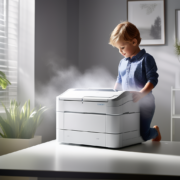Unsichtbare Gefahr im Innenraum – Zeit zur Schaffung wissenschaftliche Evidenz zur Luftverschmutzung durch ultrafeine Partikel und deren Wirkung auf die Gesundheit
Seit über drei Jahrzehnten kämpfen Menschen, die von den Emissionen von Laserdruckern und Kopierern betroffen sind, um Anerkennung, Verständnis und Schutz. Was als Gesundheitsbeschwerden Einzelner begann, hat sich zu einem bedeutenden Problem der öffentlichen Gesundheit entwickelt – gestützt durch Daten, Fallberichte und wissenschaftliche Erkenntnisse.
Über viele Jahre hinweg hat sich gezeigt, dass Büroumgebungen, die harmlos erschienen, eine zentrale Rolle bei diesem Problem spielen. Tausende haben sich bei nano-Control, Internationale Stiftung immer wieder mit ähnlichen Symptomen gemeldet. Alle waren den Emissionen aus Bürogeräten, wie Laserdrucker und Kopierer ausgesetzt und sahen dies als die Ursache ihrer Gesundheitsbeschwerden.
Die ehrenamtliche Stiftung nano-Control hat sich von einer Bürgerinitiative zu einer Wissens- und Interessenvertretungsplattform entwickelt. Weiterlesen



 nano-control - Playground KI
nano-control - Playground KI

 nano-Control
nano-Control air-Q/Canva.com
air-Q/Canva.com